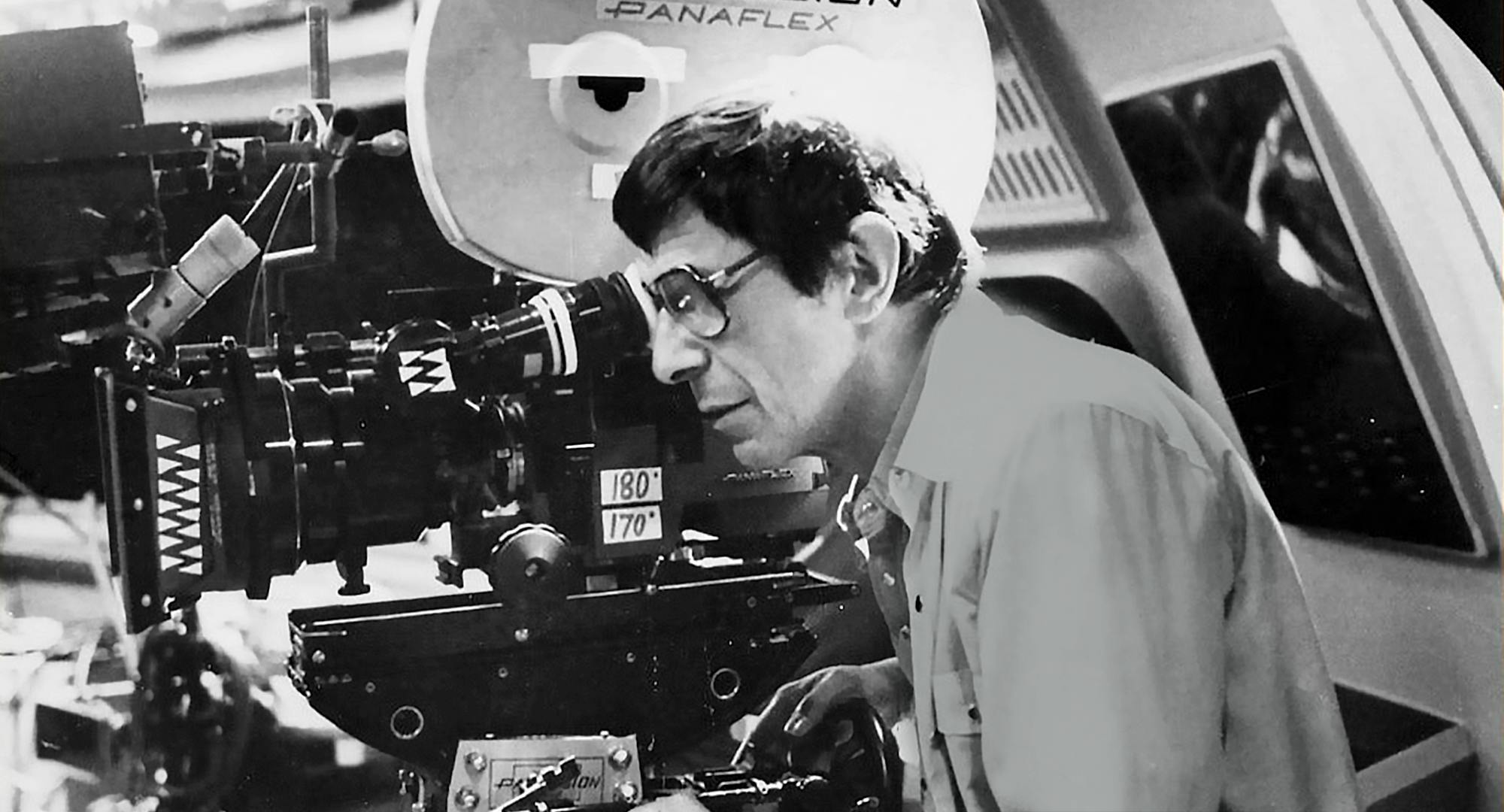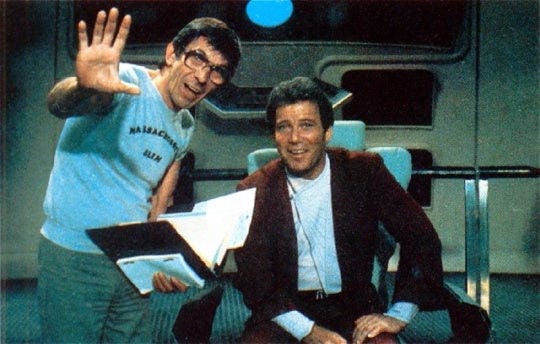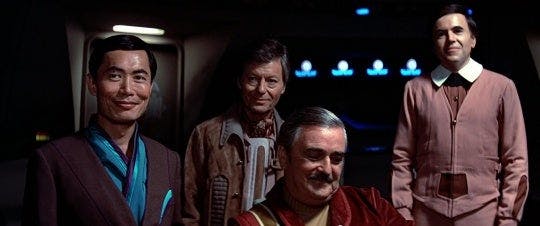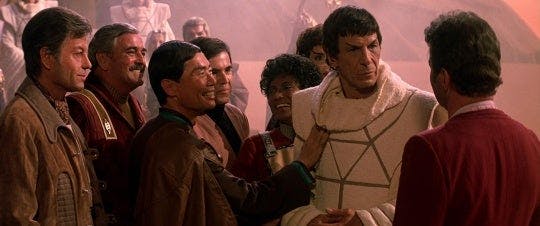Published Feb 27, 2021
How The Search For Spock Changed the Way Star Trek Got Made
The third Star Trek film helped shape the future of the franchise

StarTrek.com
There are several pivotal turning points in the production history of Star Trek. Pinning down the most important ones is tricky — is filming of “The Cage” more impactful than casting the second pilot, “Where No Man Has Gone Before?” What about the writing approach in Season 3 of The Next Generation? Which events truly define how Star Trek was made and why? Among the likely candidates, the moment when Leonard Nimoy took over directorial duties for Star Trek III: The Search For Spock tends to be overlooked. One June 1, 1984, The Search For Spock was released, becoming the very first Trek production crafted by one of the actors. And the way Star Trek was created behind-the-scenes would never be the same.
The confident energy behind-the-scenes of the Star Trek II: The Wrath of Khan meant that the pre-production conversations for a sequel were happening well before that film was released. Before The Wrath of Khan began filming, the idea of a series of Star Trek films wasn’t a foregone conclusion, but as it got going, the sequel seemed to be a lock. While Nicholas Meyer was still behind the camera, producer Harve Bennett, in collaboration with Leonard Nimoy crafted the moment in The Wrath of Khan when Spock says “Remember” and briefly mind-melds with Bones. This gave them a way to bring Spock back to life, even if they weren’t sure how it would happen. “What, exactly, was McCoy going to ‘remember’?” Nimoy wrote in his 1995 memoir I Am Spock. “What the studio wanted was clear...what wasn’t so clear was what I wanted.”
Once Leonard Nimoy decided he did want to be part of Star Trek III, he realized it would allow him to fulfill something he’d wanted to do since The Original Series — get behind the camera and direct. Turns out, both Nimoy and Shatner had wanted to direct episodes of The Original Series during its initial run in the ‘60s, but were turned down at various points. For Nimoy, this wasn’t just about an extra paycheck though. “Money wasn’t the major issue,” Nimoy makes clear in I Am Spock. “What I wanted most was an interesting challenge.”

StarTrek.com
That challenge turned out to be directing his first major feature film, Star Trek III: The Search For Spock. This was a major turning point for the Star Trek family, mostly because by having one of the actors behind the camera, the way Trek was crafted became more blended. Star Trek has always benefitted from an infusion of outside talent to create some of its most thrilling and memorable moments — Nicholas Meyer directing The Wrath of Khan and Morgan Gendel writing “The Inner Light” spring to mind. But, as a balancing force, sometimes, Star Trek kept things in the family, and became, arguably, more emotionally potent because of it.
Star Trek III: The Search For Spock is seldom listed as the greatest Trek film of all time, but it was the first of the TOS movies that treated the entire cast of characters as an ensemble. The Motion Picture wasn’t really about the whole cast. The Wrath of Khan certainly wasn’t. But The Search For Spock highlighted each and every character’s abilities in the heroic quest to snag the Enterprise and retrieve Spock’s body from the Genesis Planet. This, as it turns out, was a specific goal of Leonard Nimoy. As he crafted the story with Harve Bennett, Nimoy was inspired to make sure everyone in the cast got a fair shake. But his inspiration to do this came from a surprising source: Mission: Impossible.
“In part, I think I was influenced by my experience on Mission: Impossible, where each character had a specific job to complete in any given adventure,” Nimoy revealed in I Am Spock. “We worked, very consciously, to define special moments for each of the Enterprise bridge crew.” From 1969 to 1971, Nimoy played a master-of-disguise named the Great Paris on Mission: Impossible. This kind of super-team approach clearly influences the crew of the Enterprise in their mission to break Bones out of jail, hijack the Enterprise, and, eventually, pick-up Spock’s body from the Genesis Planet and bring it back to Vulcan. When you consider how close-knit the crew feels in this movie, it’s sort of impossible to imagine the movie not being directed by Nimoy. At that time, he was keenly aware of what the fans wanted, and also, what they expected from the characters. The Motion Picture and The Wrath of Khan are each wonderful pieces of art, but they may not have presented the crew as the family that the fans remembered. After The Search For Spock, that approach became the norm.

StarTrek.com
In it of itself, this third film extended the cinematic reach of Star Trek in ways fans had previously only dreamed of. It paved the way for Nimoy to direct the next sequel, the beloved Star Trek IV: The Voyage Home. And, it set a precedent that allowed William Shatner to direct one of my favorite Trek films, The Final Frontier. This led to a Star Trek tradition that redefined the franchise.
In the era of Star Trek: The Next Generation, another first-officer of the Starship Enterprise — Jonathan Frakes — made the leap from actor to Star Trek director. Of course, Frakes is famous to Star Trek fans as William T. Riker, but after he directed the TNG episode, “The Offspring” in 1990, like Leonard Nimoy, he changed the way The Next Generation was made. This culminated in Frakes directing fan and critical favorite Star Trek: First Contact in 1996. Other actors from The Next Generation, Deep Space Nine, and Voyager all directed episodes, including Avery Brooks, Rene Auberjonois, LeVar Burton, Patrick Stewart, Brent Spiner, Michael Dorn, Alexander Siddig, Gates McFadden, Robert Duncan McNeil, Roxann Dawson, Andrew Robinson, Tim Russ, and Robert Picardo.
Had Leonard Nimoy not directed The Search For Spock would this have happened? Jonathan Frakes clearly kicked open the door for actors directing episodes of the Star Trek spin offs, but it’s hard to imagine this idea being accepted by Rick Berman back in 1990 had Nimoy not done something similar in 1984. In some ways, by Nimoy becoming the director of a Star Trek film in the ‘80s, he created a context through which the literal next generation of Star Trek actors were able to do what he and Shatner wanted to do in the ‘60s.
To this day, Jonathan Frakes continues to be a strong directorial presence on Star Trek: Discovery and Star Trek: Picard. Famed composer Michael Giacchino even directed the animated Short Treks episode, “Ephraim and DOT.” Could we see a future where one of the Discovery actors directs an episode? Could Rebecca Romijn direct an episode of Strange New Worlds? Assuming any of these actors wanted to, it seems possible that they could, thanks to the bravery, intelligence, and kindness of Leonard Nimoy.

StarTrek.com
The Search For Spock wasn’t an egotistical project. Spock might be in the title, and Nimoy its director, but this was the first Star Trek story that allowed the rest of the ensemble to each shine in their own unique ways. It's a generous film. Generous to both the characters and to the fans. It's a unifying story that could only have been guided by someone who was part of the family. In becoming the director of The Search For Spock, Nimoy gave the Star Trek franchise a huge gift. The universe might be expanding in real life, but by bringing the Trek family in for a huge hug in The Search For Spock, Nimoy made the famous outer space family closer.
The proof is clearly in the last shot of the movie. As Spock recalls the name of his closest friend — “Jim, your name, is Jim,” the rest of the cast surrounds him. Nimoy made a bold choice with The Search For Spock. He suggested the franchise might not only be about aliens and exploration, but instead, about family. He was right.
Ryan Britt's (he/him) essays and journalism have appeared in Tor.com, Inverse, Den of Geek!, SyFy Wire, and elsewhere. He is the author of the 2015 essay collection Luke Skywalker Can't Read. He lives in Portland, Maine, with his wife and daughter.

